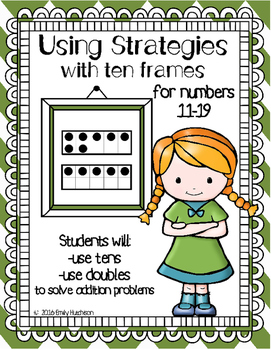Because math did not make a lot of sense to me growing up, I tend to think about many of skills from a
So as I was trying to think about how I could help my students understand "using a ten" to add numbers, I decided to start with a comic strip. Engaging, explicit, and a great place to start at a basic level.
Step 1: The Explanation
My daughter is in first grade this year and loves (nope...is obsessed) with comic strips. I knew this would interest her right away. She read through the comic with me. The dialogue plus the ten frames helped her to understand the strategy that I wanted her to try out.
Step 2: Scaffolding
After discussing the comic strip, she was ready to try it out. We folded the sheet and she used the ten frames and "using ten" strategy to solve 5 + 8. Then we unfolded the paper and checked her work. It was good practice because she was able to try it out and compare it to the comic strip characters, but I was still able to support and scaffold.
Step 3: Practice
 Now it is time to actually apply and practice the strategy. Depending on the student, there are two choices for independent practice.
Now it is time to actually apply and practice the strategy. Depending on the student, there are two choices for independent practice.The first one breaks the skill down into parts.
This sheet shows two ten frames. The student needs to find a way to make ten. Then they add the remaining dots. Students write the equation to make 10 and the equation to add the remaining dots. This sheet works specifically on the number 12 because some students need repeated practice with just one number at a time.
Making the number bond for 10 first is really helpful for students that don't know their facts of ten very well.
The second option still has the ten frames visual. That way students still have the support to make the ten prior to solving the problem.
Having this picture really helped my daughter to visualize that she was making a ten as she added the two numbers together. She was just not quite ready to give up that visual, yet.
Step 4: Independence
After these different steps and visuals, my hope is for my daughter and my students to be able to "use a ten" to add numbers without the visual. And if they are not ready, then more practice is needed with additional sheets or more practice at the concrete stage.
I will be using this procedure (plus hands-on materials) to teach both the "using ten" and "using doubles" strategies.
I would love to know if these types of visuals help your students. Or have you found something else that works even better?!
We have been trying out some new strategies in our classroom for math facts...can't wait to share those with you soon!




Starting with an engaging hook is a powerful place to start. It's so meaningful. You're always great at that!
ReplyDelete